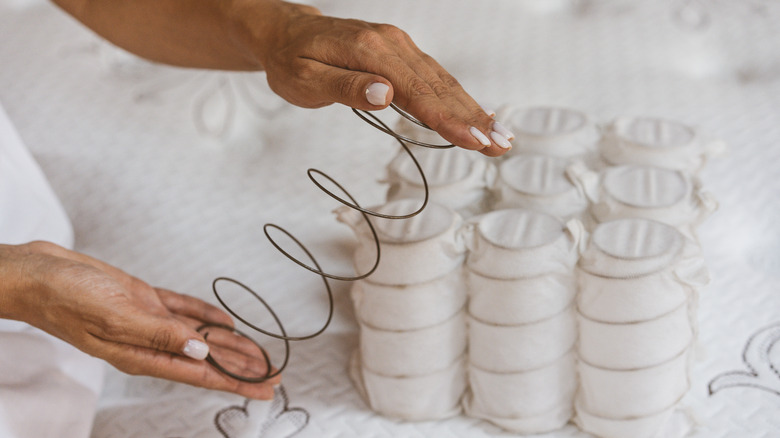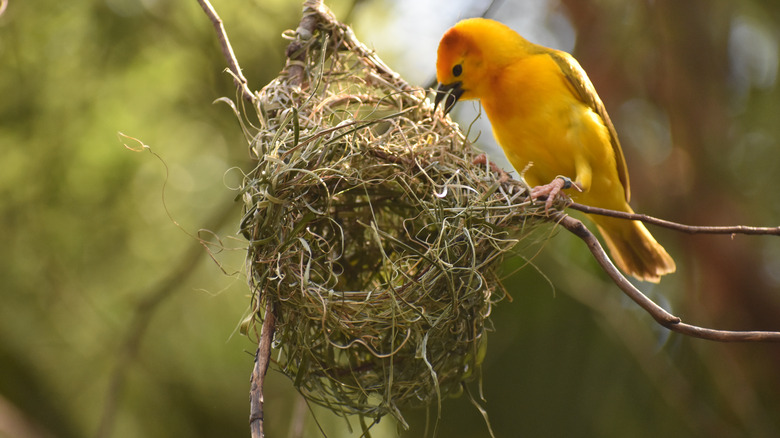Reuse A Rusty Mattress Spring To Attract More Birds To Your Yard
So, you're wondering what to do with an old mattress spring. It's a relic from dreamy nights, now apparently begging to be tossed into the nearest dumpster. But wait just a minute — don't be hasty to chunk it out yet. What if you could turn this seemingly useless piece of junk into a bird magnet for your yard? Yes, with its spiral coils and a touch of vintage charm, that old bed spring can embark on a glorious second act as a nest starter for your feathered friends. And it doesn't take much. Simply give the spring a once-over to smooth out any hazards, load it with natural nesting materials, and then hang it where birds are most likely to drop by.
This DIY not only breathes new life into your old bed springs, but also turns your yard into a bird paradise. And at what cost? Pretty much nothing — you're essentially getting crafty with what you already have in your house and yard. Throw in a bird feeder and a water fountain nearby and voila, you've set up an irresistible stopover for a broad variety of birds. The real treat is watching birds zip in and out, gathering bits for their nests. Plus, attracting more birds to your yard means a boost in pollination and reduced bug populations. Take warblers, for instance — they munch on aphids, caterpillars, and leafhoppers that mess with your veggies. Doesn't that sound like a win-win?
Making a nest starter for your yard using an old mattress spring
Repurposing an old bed spring into a bird nest starter begins with inspecting the spring for sharp bits that might harm your feathered friends. Snip or bend them away with wire cutters or pliers, and smooth anything jagged with a file. Next, scavenge for the finest nesting materials right in your backyard — think natural, like the stuff birds pick in the wild: dried grass, moss, leaves, and even sheep wool. Just make sure it's all chemical-free.
Now, secure chicken wire to the broader section of the spring to keep your nest-building supplies from slipping through. You could even add a couple of wires stretched from the top to the bottom on the opposite sides. Then, take all those gathered materials and mix them up into one big stuffing that you can start packing into the spring, layer by layer. Stuff it tightly enough to withstand a breezy day, but loose enough so birds can easily pull out bits for their new homes.
When it comes to hanging your DIY nest starter, go the simple route of securing it to something solid with a string or ribbon, or, if you're feeling a bit more DIY, attach a metal hook on there. Wondering about the perfect spot to nestle this creation? Consider a tree, shrub, or even a standalone shepherd hook in an area where the wind won't turn it into a merry-go-round; too much swinging around will deter those winged pals.
Considerations for this DIY
When it comes to decking the bed spring with the best nest materials, there are a couple of options to steer clear of. Dryer lint, for example, harbors cleaning chemicals, not to mention it breaks down when drenched. Human hair and pet fur? If they've been treated with chemicals, that's a thumbs down, too. Anything long and stringy can be a trap for birds unless you snip them into tiny, manageable pieces. Plus, you could tailor the nest filler to fit the preferences of the birds you're keen on luring in. Hummingbirds have a thing for spider silk, while flycatchers and swallows are all about that soft fluff, like chicken feathers, in their homes.
Now, for that extra touch, set up a bird bath and feeder close to the nest starter. In the event you lack something solid for the base, hang the bed spring with the wider part up top so the nesting goodies you've tucked in stay put. Once in a while, check your DIY nest starter to ensure it's insect and mold-free. You must also freshen up the nesting materials when they start to dwindle. Of course, your little nest starter won't be in use year-round by the birds. So why not make it multipurpose? When the nesting season is out, clear out the materials and flip the spring into a bird feeder come winter — you only need to secure a birdseed ball to the broader end.

